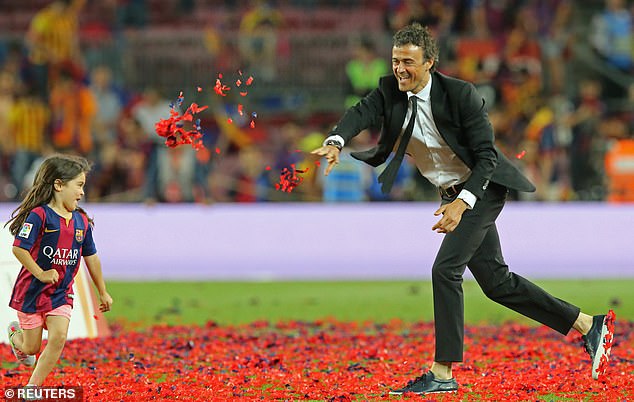
The Heartbreaking Loss of Xana: Understanding Luis Enrique’s Daughter’s Death Reason
The death of Xana, the daughter of former Barcelona and Spain coach Luis Enrique, sent shockwaves through the football world and beyond. The tragic news, announced in August 2019, brought an outpouring of grief and support for Enrique and his family. Understanding the circumstances surrounding Luis Enrique’s daughter Xana’s death reason is crucial to appreciating the family’s immense loss and the impact it had on the sporting community.
A Devastating Diagnosis: The Reason Behind Xana’s Death
Luis Enrique’s daughter Xana was diagnosed with osteosarcoma, a rare and aggressive form of bone cancer. This diagnosis came after a five-month battle that the family kept largely private. The disease primarily affects children and adolescents, making Xana’s young age all the more heartbreaking. Osteosarcoma is characterized by the rapid growth of cancerous cells in the bone, often requiring intensive treatment including chemotherapy, surgery, and radiation therapy. The specific details of Xana’s treatment plan were kept confidential, respecting the family’s privacy during such a difficult time.
Understanding Osteosarcoma
Osteosarcoma is a type of cancer that begins in the bones. It’s most often found in the long bones of the arms and legs, near the knees or shoulders, but it can occur in any bone. While relatively rare, it is the most common type of bone cancer in children and teens. The exact cause of osteosarcoma is not fully understood, but genetic factors, previous radiation exposure, and certain bone disorders may increase the risk.
- Symptoms: Common symptoms include bone pain, swelling, and limited range of motion near the affected area. A lump may also be felt.
- Diagnosis: Diagnosis typically involves imaging tests such as X-rays, MRI scans, and bone scans, as well as a biopsy to confirm the presence of cancer cells.
- Treatment: Treatment usually involves a combination of chemotherapy to kill cancer cells, surgery to remove the tumor, and sometimes radiation therapy. The specific treatment plan depends on the stage and location of the cancer, as well as the patient’s overall health.
Luis Enrique’s Public Announcement and the Outpouring of Support
Luis Enrique shared the devastating news of Xana’s death on his social media channels, expressing the family’s profound grief and gratitude for the medical teams who fought tirelessly to save her life. His statement was met with an immediate and overwhelming wave of support from football clubs, players, coaches, and fans worldwide. The football community united in mourning, offering condolences and messages of solidarity to Enrique and his family.
Enrique’s statement read, in part: “Our daughter Xana has passed away this afternoon at the age of 9 after fighting for 5 intense months against osteosarcoma. We thank all the people for the affection received during these months and we appreciate the discretion and understanding.”
The Impact on Luis Enrique’s Career
Prior to Xana’s death, Luis Enrique had stepped down as the coach of the Spanish national team in June 2019, citing personal reasons. While the specific reason wasn’t initially disclosed, it later became clear that he had been dedicating his time to caring for Xana during her illness. The emotional toll of his daughter’s illness and subsequent passing understandably had a significant impact on his personal and professional life.
Following Xana’s death, Enrique took a break from football management. He eventually returned to coach the Spanish national team again in November 2019, demonstrating incredible resilience and determination in the face of unimaginable loss. His return was widely celebrated, with many viewing it as a testament to his strength and character.
Xana’s Legacy: Raising Awareness and Supporting Research
The tragic passing of Luis Enrique’s daughter Xana has brought increased attention to osteosarcoma and the need for further research and improved treatments. Many organizations and individuals have been inspired to raise awareness and funds to support research efforts aimed at finding better cures and improving the lives of children and families affected by this devastating disease. [See also: Childhood Cancer Research Funding]
The family’s openness about their experience, while intensely personal, has helped to break down stigmas surrounding childhood cancer and encourage open conversations about the challenges faced by families dealing with such diagnoses. Luis Enrique himself has become an advocate for cancer research and support, using his platform to raise awareness and inspire hope.
Remembering Xana: A Life Cut Short
While the focus is often on the circumstances surrounding Xana’s death reason, it’s essential to remember her as a young girl who brought joy and love to her family and those around her. Her life, though tragically short, left a lasting impact on those who knew her. The outpouring of support following her passing is a testament to the love and admiration that people held for the Enrique family.
The story of Luis Enrique’s daughter Xana serves as a reminder of the fragility of life and the importance of cherishing every moment. It also highlights the need for continued research and support for families battling childhood cancer. Xana’s memory lives on, inspiring hope and resilience in the face of adversity.
Conclusion
The death of Xana, Luis Enrique’s daughter, from osteosarcoma was a profound tragedy that deeply affected the football world and beyond. Understanding the reason behind her death sheds light on the devastating impact of this rare form of bone cancer. Her legacy continues to inspire awareness and support for childhood cancer research, ensuring that her memory lives on and contributes to a better future for other children and families facing similar challenges. The strength and resilience shown by Luis Enrique and his family in the face of such immense loss serve as an inspiration to us all. [See also: Coping with Grief and Loss]
